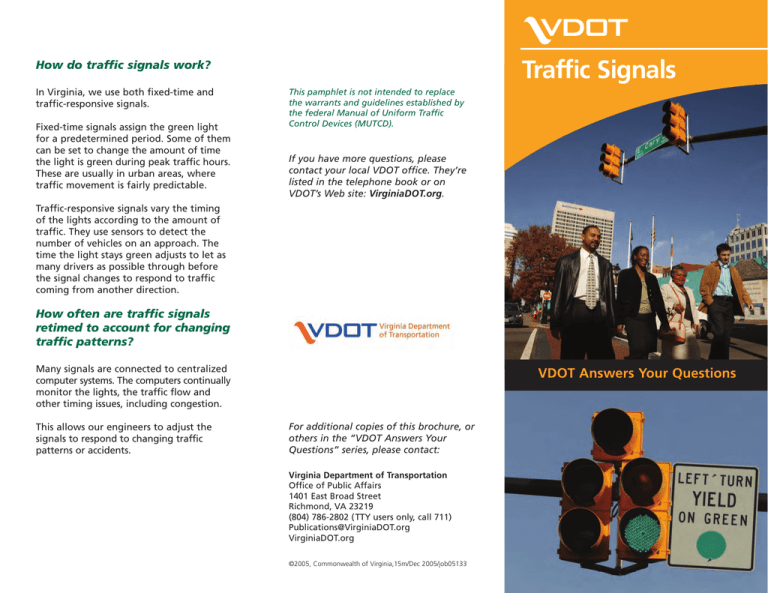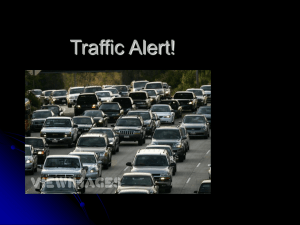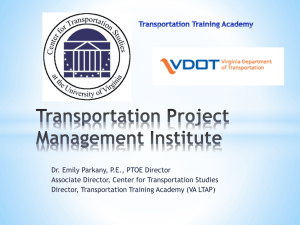Traffic Signals - Virginia Department of Transportation
advertisement

Traffic Signals How do traffic signals work? In Virginia, we use both fixed-time and traffic-responsive signals. Fixed-time signals assign the green light for a predetermined period. Some of them can be set to change the amount of time the light is green during peak traffic hours. These are usually in urban areas, where traffic movement is fairly predictable. This pamphlet is not intended to replace the warrants and guidelines established by the federal Manual of Uniform Traffic Control Devices (MUTCD). If you have more questions, please contact your local VDOT office. They’re listed in the telephone book or on VDOT’s Web site: VirginiaDOT.org. Traffic-responsive signals vary the timing of the lights according to the amount of traffic. They use sensors to detect the number of vehicles on an approach. The time the light stays green adjusts to let as many drivers as possible through before the signal changes to respond to traffic coming from another direction. How often are traffic signals retimed to account for changing traffic patterns? Many signals are connected to centralized computer systems. The computers continually monitor the lights, the traffic flow and other timing issues, including congestion. This allows our engineers to adjust the signals to respond to changing traffic patterns or accidents. VDOT Answers Your Questions For additional copies of this brochure, or others in the “VDOT Answers Your Questions” series, please contact: Virginia Department of Transportation Office of Public Affairs 1401 East Broad Street Richmond, VA 23219 (804) 786-2802 ( TTY users only, call 711) Publications@VirginiaDOT.org VirginiaDOT.org ©2005, Commonwealth of Virginia,15m/Dec 2005/job05133 How VDOT Decides When and Where to Install Traffic Signals What is the purpose of a traffic signal? Are traffic signals a cure for crashes? Those red, yellow and green lights are vital to controlling traffic in a safe and orderly manner. They let motorists “take turns” passing through busy intersections, and they can enhance safety. A traffic signal assigns the right of way to approaching vehicles at intersections where it has been determined, using specific technical indicators, that it would be advantageous to do so. Not in all cases. Some types of crashes can be reduced by installing a signal. But other types might not be affected. VDOT engineers generally recommend a traffic signal be installed at intersections when the number of crashes is abnormally high between vehicles approaching from different directions. But, in the wrong location, a traffic signal can contribute to crashes and congestion. The potential for a crash exists every time a vehicle is stopped on the highway. Almost every driver has experienced the anxiety of approaching an intersection and having a light suddenly turn yellow. Likewise, most of us know the frustration of getting caught at one red light after another when traveling on a busy thoroughfare. The Virginia Department of Transportation’s job is to find the location where a signal light will help traffic more than hinder it. The point of having a traffic light is to relieve congestion, not cause it. VDOT’s primary concern is the safety of those using the intersection. The signal is placed to ensure a safe and orderly traffic flow, to protect pedestrians and vehicles crossing the intersection, and to help lessen the severity and frequency of crashes. How does VDOT decide if a traffic signal should be installed? The department follows federal guidelines that establish the minimum conditions that should exist before installing a signal. These guidelines help identify potential signal locations, but each intersection is reviewed before a traffic light is placed there. Traffic engineers evaluate: • the number of vehicles and pedestrians that use an intersection • the intersection’s physical makeup • nearby development • traffic delays during peak hours • average vehicle speeds • future construction plans • the crashes that have occurred there But, they make sure the signal will help alleviate the problem, and it is installed only if other remedies are unsatisfactory. Traffic signals don’t eliminate rear-end collisions. Can signals contribute to crashes and congestion? Definitely. Traffic signals are valuable tools, but they’re not a cure-all. Sometimes a signal can contribute to rear-end collisions, excessive delays, unnecessary use of alternate routes, and congestion.

